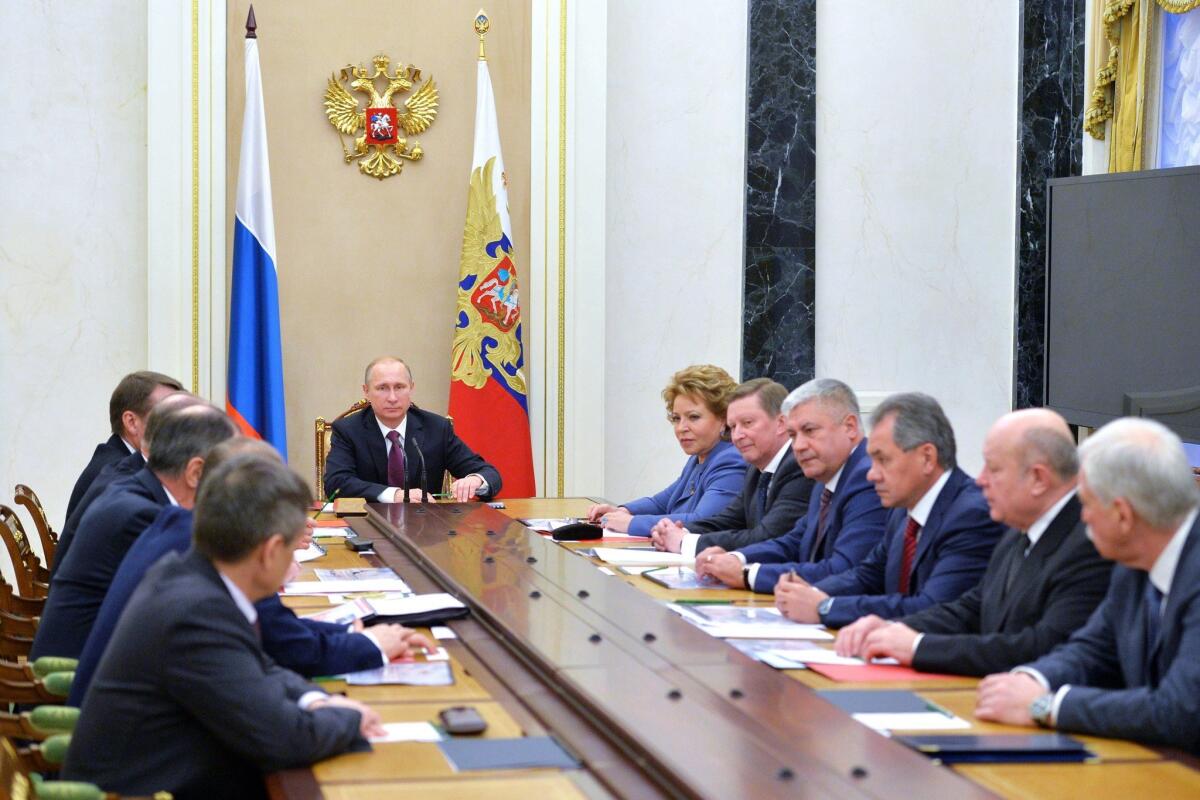Russia revises military doctrine to name NATO as chief threat

Russian President Vladimir Putin on Friday signed into law a new defense doctrine that identifies NATO as the chief threat to Russian security and claims the right to use nuclear weapons to counter any aggression that “threatens the very existence” of Russia.
The revisions to the 2010 defense mission statement were few but appeared intended to put further pressure on the United States and the Western military alliance to cease courting Ukraine as an economic and strategic ally.
The North Atlantic Treaty Organization has moved forces closer to Russia’s borders in response to the Kremlin’s annexation of Ukraine’s Crimea region in March and its dramatically increased challenges of the alliance’s airspace and maritime borders. NATO officials report that the number of aerial and maritime intrusions by Russian fighter jets in the Baltic Sea area has more than tripled this year over last.
The new defense doctrine cites NATO troop deployments and induction of former Soviet-allied states as the top threat to Russian security. It also deems the developing Prompt Global Strike program of the United States as hostile. The precision weapons system is being designed to be able to strike anywhere in the world so swiftly that the target has too little time to respond.
The new doctrine also mentions NATO missile defense plans as destabilizing and for the first time identifies a priority for Russia to protect its natural resource and maritime interests in the Arctic Sea.
Russia needed to update its defense doctrine to address “the emergence of hotbeds of interethnic and interreligious tensions, the operations of militarized international radical groupings and foreign private military companies in the areas adjoining the borders of the Russian Federation and its allies,” the 29-page document posted on the Kremlin website [link in Russian] reads.
It also cited the rise in “territorial contradictions and a growth of separatism/extremism” as pressures on Russian security.
The amendments were approved by the Russian Security Council on Dec. 19 and signed Friday by Putin, the Kremlin website reported.
Among the security threats it identifies in the doctrine is “the creation and deployment of global strategic antiballistic missile systems that undermine the established global stability and balance of power in nuclear missile capabilities.”
The doctrine makes clear that Russia considers NATO expansion into the realm of Soviet-era influence to be aggressive. The document accuses the Western alliance of having adopted “global functions realized with violation of international law.”
Putin has repeatedly portrayed the induction of former Soviet allies of the Warsaw Pact as encroachment and provocation.
A NATO spokeswoman countered that the alliance is defensive in nature and pointed to Russia’s Crimea seizure as evidence that it is Russia, not the West, that has acted in violation of international treaties.
“NATO poses no threat to Russia or to any nation. Any steps taken by NATO to ensure the security of its members are clearly defensive in nature, proportionate and in compliance with international law,” said alliance spokeswoman Oana Lungescu from NATO headquarters in Brussels. “In fact, it is Russia’s actions, including currently in Ukraine, which are breaking international law and undermining European security.”
NATO officials have said that when and if Ukraine applies to join the alliance -- a prospect unlikely before 2020 at the earliest because of the country’s need to make wide-ranging internal reforms -- the matter would be considered without third-party interference.
Russian defense officials this week accused U.S.-led NATO of attempting to lure Ukraine into the 28-nation alliance, an effort they described as turning the westernmost former Soviet state into a “front line of confrontation.”
NATO already includes the former Soviet republics of Estonia, Latvia and Lithuania, as well as the Eastern European countries that were allied with Moscow during the Cold War.
Fighting in eastern Ukraine between Moscow-backed separatists and Ukrainian government troops flared just days after the Kremlin annexed Ukraine’s Crimea peninsula March 18. The pro-Russia separatists have proclaimed independent republics in the Donetsk and Luhansk regions, elected new leaders and demanded recognition of their sovereignty by the Kiev government.
An effort this week to restart peace talks between the rebels and the Ukrainian government faltered after Ukrainian lawmakers voted Tuesday to renounce the country’s nonaligned status.
The revised wording of the defense doctrine appeared to reflect Russia’s heightened sensitivities over Ukraine’s drift out of Moscow’s traditional sphere of influence. Pro-Kremlin Ukrainian President Viktor Yanukovich was ousted in late February by a rebellion against his decision to scrap an association agreement with the European Union in favor of even tighter economic ties with Russia.
Putin and other top Kremlin officials deemed the ouster of their ally Yanukovich a coup d’etat and seized Crimea in a move they justified as protection of the peninsula’s predominantly Russian population.
Russian officials have recently alluded to what they claim is their right to station nuclear defenses in Crimea, and the newly revised defense doctrine asserts Russia’s right to use such weapons in retaliation for any attack with weapons of mass destruction or anything that “threatens the very existence” of the Russian state.
Follow @cjwilliamslat for the latest international news 24/7.
More to Read
Start your day right
Sign up for Essential California for news, features and recommendations from the L.A. Times and beyond in your inbox six days a week.
You may occasionally receive promotional content from the Los Angeles Times.







